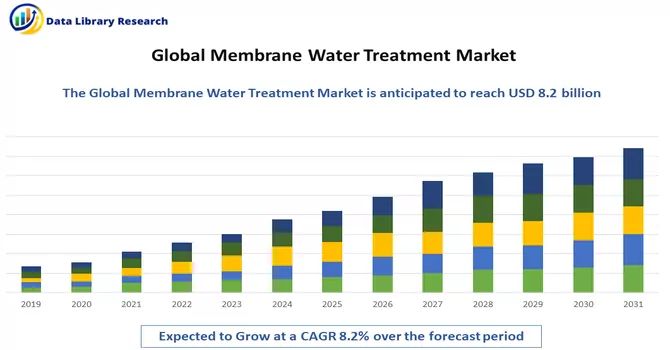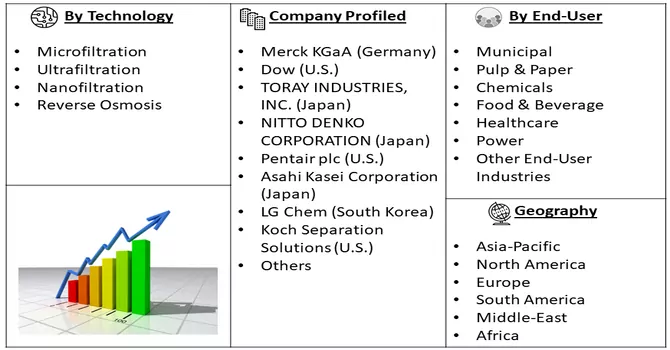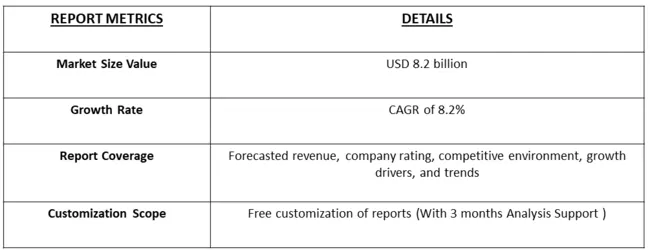The membrane filtration market is estimated at USD 8.2 billion in 2024 and is expected to register a CAGR of 8.2% from 2024 to 2031.

Get Complete Analysis Of The Report - Download Free Sample PDF
Membrane water treatment has emerged as a transformative solution in the global water treatment market, gaining prominence for its efficiency in addressing diverse water purification challenges. This technology employs semi-permeable membranes to selectively separate and remove contaminants, such as bacteria, viruses, and pollutants, from water sources. The market for membrane water treatment is witnessing robust growth due to increasing concerns about water scarcity, population growth, and industrial expansion. Key advantages, including reduced energy consumption, minimal chemical usage, and the ability to produce high-quality treated water, position membrane water treatment as a sustainable and cost-effective solution.
As industries and municipalities seek innovative approaches to meet stringent water quality standards, the membrane water treatment market is expected to continue its upward trajectory, providing a crucial tool in ensuring access to clean and safe water resources globally. The membrane water treatment market is propelled by several compelling growth-driving factors, primarily fueled by escalating global concerns regarding water scarcity and the imperative for sustainable water management solutions. The increasing population, rapid urbanization, and industrial expansion are intensifying the demand for clean and safe water, positioning membrane water treatment as a pivotal technology. With a focus on achieving stringent water quality standards and addressing environmental concerns, industries and municipalities are increasingly adopting membrane-based systems for their efficiency in removing contaminants. Additionally, advancements in membrane technology, such as enhanced permeability and durability, are bolstering the market's growth. The rising awareness of the cost-effectiveness and sustainability of membrane water treatment, characterized by reduced energy consumption and chemical usage, further contributes to its expanding adoption, underscoring its crucial role in meeting the escalating global demand for accessible and clean water resources.
Market Segmentation: The membranes for Water and Wastewater Systems Market Growth it is segmented by Technology (Microfiltration, Ultrafiltration, Nanofiltration, and Reverse Osmosis), End-User Industries (Municipal, Pulp & Paper, Chemicals, Food & Beverage, Healthcare, Power, and Other End-User Industries), and Geography (Asia-Pacific, North America, Europe, South America, and Middle East and Africa). The market size and forecasts for the membrane water and wastewater treatment market are Provided in revenue (USD million) for all the above segments.

For Detailed Market Segmentation - Download Free Sample PDF
The membrane water treatment market is witnessing significant trends that reflect the evolving landscape of water purification technologies. Notably, there is a growing emphasis on the integration of smart technologies and automation in membrane water treatment systems, enhancing monitoring, control, and overall operational efficiency. Additionally, a shift towards more sustainable practices is evident, with a focus on developing eco-friendly membranes and promoting energy-efficient processes within the market. The adoption of decentralized water treatment solutions, driven by their flexibility and ability to serve smaller communities, is gaining traction. Furthermore, advancements in membrane materials, such as graphene-based membranes, are contributing to improved filtration performance and longevity. As water quality regulations become more stringent worldwide, the membrane water treatment market is experiencing a trend towards modular and scalable solutions that can cater to varying water treatment needs, ensuring adaptability in diverse applications and industries. These trends collectively underscore the market's commitment to innovation, sustainability, and meeting the rising demand for efficient and environmentally responsible water treatment solutions.
Market Drivers:
The increasing global focus on water scarcity
The escalating global focus on water scarcity has become a paramount concern as burgeoning populations, climate change, and rapid urbanization amplify the strain on water resources. With regions worldwide facing acute water shortages and increasing frequency of droughts, governments, businesses, and communities are intensifying their efforts to address this critical issue. The imperative for sustainable water management practices is driving a paradigm shift towards innovative technologies and solutions. Membrane water treatment, as a key player in this landscape, is gaining prominence for its ability to efficiently purify and recycle water, offering a viable means to mitigate the impacts of water scarcity. As a result, the imperative to secure water availability for future generations is steering a global narrative that places water scarcity at the forefront of environmental, social, and economic agendas.
The stringent regulatory standards governing water quality
The stringent regulatory standards governing water quality have become a pivotal force shaping environmental policies globally. Governments and regulatory bodies worldwide are increasingly recognizing the imperative of ensuring safe and clean water for communities and ecosystems. Stringent standards are set to safeguard public health, ecosystems, and biodiversity, necessitating the implementation of advanced water treatment technologies. Membrane water treatment emerges as a cornerstone in meeting these rigorous quality benchmarks, offering an effective solution for the removal of contaminants. This regulatory framework not only propels the adoption of membrane water treatment systems across various industries but also underscores the commitment to sustainable and compliant water management practices, aligning with the broader goal of securing access to high-quality water resources for present and future generations.
Market Restraints:
The membrane water treatment market faces certain constraints, with notable challenges including high upfront costs and operational expenses associated with the installation and maintenance of membrane systems. Despite long-term benefits, the initial capital investment often acts as a barrier to entry for some end-users, particularly in smaller or economically constrained communities. Additionally, membrane fouling, scaling, and degradation over time can reduce the efficiency and lifespan of membranes, necessitating regular cleaning and replacement, which further adds to operational costs. The energy-intensive nature of some membrane processes is another restraint, as it may offset the environmental benefits of water treatment. Furthermore, limited public awareness and understanding of membrane water treatment technologies, particularly in developing regions, can hinder widespread adoption. Overcoming these challenges requires ongoing technological advancements, cost-reduction measures, and effective education and outreach programs to promote the broader acceptance and implementation of membrane water treatment solutions.
The COVID-19 pandemic has presented both challenges and opportunities for the membrane water treatment market. On one hand, the heightened awareness of the importance of clean and safe water has underscored the significance of advanced water treatment technologies. However, the market has also faced disruptions due to supply chain interruptions, labor shortages, and delays in project implementations caused by lockdowns and restrictions. The economic downturn has impacted capital investments, particularly in industries such as hospitality and manufacturing, influencing the pace of adoption of membrane water treatment solutions. Despite these challenges, the pandemic has spurred innovation in the sector, with a renewed emphasis on remote monitoring and control technologies, as well as a growing recognition of the role of water treatment in ensuring public health. As the world transitions towards recovery, the membrane water treatment market is expected to rebound, driven by an increased focus on resilient and sustainable water management systems.
Segmental Analysis:
Ultrafiltration Segment is Expected to Witness Significant Growth Over the Forecast Period
Ultrafiltration (UF) is a membrane-based water treatment technology used to remove suspended solids, bacteria, viruses, and other pathogens from water. The UF membrane acts as a barrier, allowing water to pass through while blocking contaminants based on their size. This process is effective in producing high-quality water for various applications, including drinking water treatment, wastewater treatment, and industrial process water treatment. The UF membrane water treatment market has been experiencing significant growth due to the increasing demand for clean and safe water, stringent water quality regulations, and the need for sustainable water treatment solutions. UF systems are widely used in municipal water treatment plants, industrial facilities, and commercial buildings to improve water quality and meet regulatory standards. One of the key drivers of the UF membrane water treatment market is the growing awareness of the importance of water conservation and environmental sustainability. UF systems require less energy and chemicals compared to traditional water treatment methods, making them more environmentally friendly. Additionally, UF systems are modular and can be easily integrated into existing water treatment processes, making them a cost-effective solution for water treatment plants looking to upgrade their infrastructure. The UF membrane water treatment market is also driven by technological advancements, such as the development of more efficient membranes and system designs. These advancements have led to improved performance and lower operating costs, further fueling the adoption of UF systems in various industries. Thus, the UF membrane water treatment market is expected to continue growing as the demand for clean and safe water increases globally. With its ability to provide high-quality water treatment solutions in a cost-effective and environmentally friendly manner, UF technology is poised to play a key role in the future of water treatment.
Healthcare Segment is Expected to Witness Significant Growth Over the Forecast Period
Membrane water filters are increasingly vital in healthcare, ensuring clean and safe water for medical procedures, patient care, and laboratory use. These filters use advanced membrane technology to remove contaminants like bacteria, viruses, and particulates from water, crucial for maintaining high standards of hygiene and safety. In healthcare settings, membrane filters provide clean drinking water for patients, staff, and visitors and are integral to medical equipment such as dialysis machines and autoclaves. They are also essential in laboratories, where water purity is paramount for accurate testing and experiments. Membrane filters offer a consistent level of water quality, crucial in healthcare where waterborne infections can pose serious risks. Despite higher initial costs, membrane filters are cost-effective due to their low maintenance needs and long-term reliability. Overall, membrane water filters are indispensable in healthcare, ensuring water quality that meets the stringent standards required for medical applications.
North America Region is Expected to Witness Significant Growth Over the Forecast Period
The North American membrane filter market is witnessing robust growth driven by increasing demand across various industries such as water treatment, pharmaceuticals, food and beverage, and healthcare. Membrane filters are widely used in these industries for their ability to efficiently remove contaminants and ensure product quality and safety. Factors such as stringent environmental regulations, growing awareness about waterborne diseases, and the need for sustainable water treatment solutions are fueling the market growth. Additionally, technological advancements in membrane filtration systems are further driving market expansion. North America's strong economy and significant investments in research and development are expected to continue driving innovation in the membrane filter market, making it a key region for market growth and development.

Get Complete Analysis Of The Report - Download Free Sample PDF
The analyzed market exhibits a high degree of fragmentation, primarily attributable to the presence of numerous players operating on both a global and regional scale. The competitive landscape is characterized by a diverse array of companies, each contributing to the overall market dynamics. This fragmentation arises from the existence of specialized solution providers, established industry players, and emerging entrants, all vying for market share. The diversity in market participants is underscored by the adoption of various strategies aimed at expanding the company presence. On a global scale, companies within the studied market are strategically positioning themselves through aggressive expansion initiatives. This often involves entering new geographical regions, targeting untapped markets, and establishing a robust global footprint. The pursuit of global expansion is driven by the recognition of diverse market opportunities and the desire to capitalize on emerging trends and demands across different regions. Simultaneously, at the regional level, companies are tailoring their approaches to align with local market dynamics. Regional players are leveraging their understanding of specific market nuances, regulatory environments, and consumer preferences to gain a competitive edge. This regional focus allows companies to cater to the unique needs of local clientele, fostering stronger market penetration. To navigate the complexities of the fragmented market, companies are implementing a range of strategies. These strategies include investments in research and development to stay at the forefront of technological advancements, mergers and acquisitions to consolidate market share, strategic partnerships for synergies, and innovation to differentiate products and services. The adoption of such multifaceted strategies reflects the competitive nature of the market, with participants continually seeking avenues for growth and sustainability. In essence, the high fragmentation in the studied market not only signifies the diversity of players but also underscores the dynamism and competitiveness that drive ongoing strategic maneuvers. As companies explore various avenues for expansion, the market continues to evolve, presenting both challenges and opportunities for industry stakeholders.
Some of the key market players working in this segment are:
Recent Development:
1) In May 2023, Xylem successfully finalized the acquisition of Evoqua Water Technologies LLC, a renowned global entity offering diverse products and technologies dedicated to water and wastewater treatment. This strategic move positions Xylem to significantly broaden its global footprint within the water treatment industry. By integrating the expertise and offerings of Evoqua, Xylem aims to strengthen its capabilities in providing comprehensive and innovative solutions for water management on a worldwide scale.
2) In March 2023, NX Filtration BV entered into a collaborative agreement with GreenTech Environmental, a leading advanced water treatment and wastewater recycling company based in China. The collaboration focuses on the establishment of a full-scale water treatment plant utilizing direct nanofiltration (dNF) membrane technology pioneered by NX Filtration BV. This cutting-edge approach is designed to deliver pure and cost-effective water solutions. The partnership aligns with the shared commitment of NX Filtration BV and GreenTech Environmental to address water scarcity challenges and promote sustainable water management practices, particularly in the context of China's evolving environmental landscape.
Q1. What was the Membrane Water Treatment Market size in 2023?
As per Data Library Research the Membrane Water Treatment Market is estimated at USD 8.2 billion in 2024.
Q2. At what CAGR is the market projected to grow within the forecast period?
Membrane Water Treatment Market is expected to register a CAGR of 8.2% over the forecast period.
Q3. What are the factors driving the Membrane Water Treatment marketane Water Treatment market?
Key factors that are driving the growth include the increasing global focus on water scarcity and The stringent regulatory standards governing water quality.
Q4. Who are the key players in Membrane Water Treatment market?
Some key players operating in the market include
Data Library Research are conducted by industry experts who offer insight on industry structure, market segmentations technology assessment and competitive landscape (CL), and penetration, as well as on emerging trends. Their analysis is based on primary interviews (~ 80%) and secondary research (~ 20%) as well as years of professional expertise in their respective industries. Adding to this, by analysing historical trends and current market positions, our analysts predict where the market will be headed for the next five years. Furthermore, the varying trends of segment & categories geographically presented are also studied and the estimated based on the primary & secondary research.
In this particular report from the supply side Data Library Research has conducted primary surveys (interviews) with the key level executives (VP, CEO’s, Marketing Director, Business Development Manager and SOFT) of the companies that active & prominent as well as the midsized organization
FIGURE 1: DLR RESEARH PROCESS

Extensive primary research was conducted to gain a deeper insight of the market and industry performance. The analysis is based on both primary and secondary research as well as years of professional expertise in the respective industries.
In addition to analysing current and historical trends, our analysts predict where the market is headed over the next five years.
It varies by segment for these categories geographically presented in the list of market tables. Speaking about this particular report we have conducted primary surveys (interviews) with the key level executives (VP, CEO’s, Marketing Director, Business Development Manager and many more) of the major players active in the market.
Secondary ResearchSecondary research was mainly used to collect and identify information useful for the extensive, technical, market-oriented, and Friend’s study of the Global Extra Neutral Alcohol. It was also used to obtain key information about major players, market classification and segmentation according to the industry trends, geographical markets, and developments related to the market and technology perspectives. For this study, analysts have gathered information from various credible sources, such as annual reports, sec filings, journals, white papers, SOFT presentations, and company web sites.
Market Size EstimationBoth, top-down and bottom-up approaches were used to estimate and validate the size of the Global market and to estimate the size of various other dependent submarkets in the overall Extra Neutral Alcohol. The key players in the market were identified through secondary research and their market contributions in the respective geographies were determined through primary and secondary research.
Forecast Model
